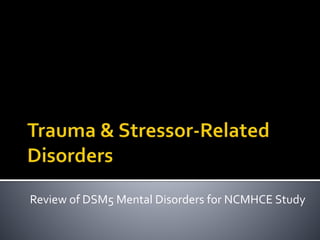Trauma & Stressor Related Disorders for NCMHCE Study
- 1. Review of DSM5 Mental Disorders for NCMHCE Study
- 2. 1. Post-Traumatic Stress Disorder 2. Acute Stress Disorder 3. Adjustment Disorders 4. Reactive Attachment Disorder 5. Disinhibited Social Engagement Disorder
- 3. S2. Assess or Refer Tests DAPS Impact of Events Scale Beck Anxiety Inventory Clinician Administered PTSD Scale PTSD Checklist Children K-SADS PTSD, of Child Behavior Checklist CBC ChildhoodTrauma Questionnaire Psychometric Evaluation, of Children’s Impact ofTraumatic Events Scale Revised CITES-R Medical evaluation
- 4. S4.Treatments 1. Medication Antidepressant Anxiolytics Anti-convulsants 2.Therapies Prolonged ExposureTherapy PET Cognitive-ProcessingTherapy CPT Multiple-Channel ExposureTherapy M-CET Stress InoculationTraining SIT Eye Movement Desensitization and Reprocessing therapy EMDR RelaxationTraining Imaginal Exposure & InVivo Exposure Trauma-focused PsychologicalTherapy Anxiety ManagementTraining
- 5. Difference is timing Post-Traumatic Stress Disorder Begins over 4 weeks after the event Acute Stress Disorder Occurs and ends within 4 weeks of the event Symptoms last at least 2 days and less than 1 month
- 7. Diagnosis I Symptom following the direct experience or indirect experience (hearing about) of a traumatic event A. One symptom in each category 1. Re-experiencing the trauma Recurring flashbacks, bad dreams or frightening thoughts 2. Altered cognitions and mood Forgetting details Irrational beliefs or thoughts about the cause of the trauma Negative emotions: guilt, worry, depression 3. Avoidance or numbing Shunning any reminders Feeling emotionally numb Detachment from people 4. Increased arousal or reactivity Hypervigilance, sleep problems Irritability, recklessness Impaired concentration
- 8. Diagnosis II 2. Onset or duration Begins over a month after the traumatic event Acute if lasting less than 3 months Chronic if persisting 3 months or more Delayed onset if the symptoms first occur after 6 months or some years late
- 9. Diagnosis III Co-occurring: Anxiety Substance abuse Bipolar Disorders Rule Out Schizophrenia & Psychotic Disorders Dissociative Disorders
- 10. S1. Find Out More 1. Details about any disturbing episode 2. Frequency, duration and intensity and specifics of symptoms 3. Affective history 4. Cognitive functioning 5. Anxiety history 6. Drug and alcohol history 7. Medical history (related to trauma) 8. Trauma and loss history 9. Potential for violence 10. Potential for suicide
- 11. S2. Assess or Refer Tests DAPS Impact of Events Scale Beck Anxiety Inventory Clinician Administered PTSD Scale PTSD Checklist Children K-SADS PTSD, of Child Behavior Checklist CBC ChildhoodTrauma Questionnaire Psychometric Evaluation, of Children’s Impact ofTraumatic Events Scale Revised CITES-R Medical evaluation
- 12. S4.Treatments 1. Medication Antidepressant Anxiolytics Anti-convulsants 2.Therapies Prolonged ExposureTherapy PET Cognitive-ProcessingTherapy CPT Multiple-Channel ExposureTherapy M-CET Stress InoculationTraining SIT Eye Movement Desensitization and Reprocessing therapy EMDR RelaxationTraining Imaginal Exposure & InVivo Exposure Trauma-focused PsychologicalTherapy Anxiety ManagementTraining
- 13. S5. Monitoring Progress Quality of sleep Proper use of medications Trauma symptom assessment Affective functioning Capacity to concentrate, etc. S6. AfterTermination Medication monitoring for compliance, to reduce high rate of relapse Medication monitoring for side effects Psychotherapies Support group
- 15. Diagnosis I Symptom following the direct experience or indirect experience of(hearing about) a traumatic event 1. One symptom in each category 1. Re-experiencing the trauma Recurring flashbacks, bad dreams or frightening thoughts 2. Altered cognitions and mood Forgetting details Irrational beliefs or thoughts about the cause of the trauma Negative emotions: guilt, worry, 3. Avoidance or numbing Shunning any reminders Feeling emotionally numb Detachment from people 4. Increased arousal or reactivity Hypervigilance, sleep problems Irritability, recklessness Impaired concentration
- 16. Diagnosis II 2. Onset or duration Symptoms last at least 2 days and less than 1 month Occur within 4 weeks of the event
- 17. Diagnosis III Co-occurring: Anxiety Substance abuse Bipolar Disorders Rule Out Psychotic Disorders
- 18. S1. Find Out Details of any disturbing episodes Medical evaluation Cognitive functioning Affective functioning Substance use history Violence and aggression history Military history Sleep disturbance
- 19. S4.Treatments 1. Medication 2.Therapies Cognitive Behavioral Therapy Exposure and REBT Relaxation, REBT, Imaginal Exposure and InVivo Exposure (can prevent PTSD)
- 21. Diagnosis I 1. Emotional or behavioral symptoms in response to an identifiable stressor Occurs within 3 months of the onset of the stressor Ends 6 months after stressor gone 2. Sufficient intensity of episode Distress is out of proportion to the severity or intensity of the stressor Impairment is significant
- 22. S1. Find Out Details of symptoms Work functioning Trauma history Substance abuse history Destructiveness or self- destructiveness, suicide history Affective functioning Cognitive functioning S2. Refer & Assess Tests SCAD
- 23. S4.Treatments Relieve acute symptoms Stress reduction techniques Therapies Psychoeducation Brief psychodynamic therapy CBT
- 24. S5. Monitoring Progress Mood charting Level of re-involvement and concern about daily activities and environment Affective functioning S6.Termination Return to therapy if relapse Support group Hobbies and stress reduction activities

